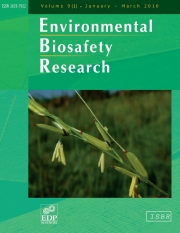No CrossRef data available.
Article contents
Towards the safe use of modern biotechnology:Report on the 7th International Symposium on the Biosafetyof Genetically Modified Organisms held in Beijing (China) October 10-16, 2002
Published online by Cambridge University Press: 15 January 2003
Abstract
Along with the introduction of genetically modified organisms in the field, both biotechnology companies and academic institutes have conducted biosafety research in order to study the potential ecological impact of the modified organisms. With the growing concerns among various stakeholders, priority has been given to academic research on biosafety-related issues. For instance, the European Commission begun funding biosafety research of genetically modified plants in 1989, right after the first experimental releases of those modified crops. In the 5th Framework EC Research program biosafety research became a key action supporting 81 projects (for details see: http://europa.eu.int/comm/research/quality-of-life/gmo/index.html).
During this period, researchers gathered regularly to exchange ideas and their latest research results in this field at different workshops and also at a series of symposia held biennially since 1990. As early as the 5th International Symposium on the Biosafety of Genetically Modified Organisms, held in Braunschweig (Germany) in 1998, the Symposium's International Advisory Committee supported an idea to launch a new peer-reviewed journal, Environmental Biosafety Research (EBR), to facilitate communication in this research area, where controversial views are constantly expressed. It is hoped that EBR will contribute to clarifying the scientific terms of the debate, and that this will be useful for decision makers and other members of society. Another important event was the incorporation of a new learned Society, the International Society for Biosafety Research (ISBR), which was decided at the the 6th Symposium held in Saskatoon (Canada) in 2000.
At the most recent Symposium, the first ISBR officers were elected: President, Alan McHughen (USA); Vice-President, Mark Tepfer (France); Secretary/Treasurer, Allison Snow (USA). Scientists who met at the 7th International Symposium in Beijing appreciated the quality of the first issue of EBR (a sample copy can be requested, and subscription purchased at: http://www.edpsciences.org/ebr/) and the possibility of registration for membership of the newly-incorporated Society. Information on becoming an ISBR member, which gives the right to a reduced subscription price for EBR, can be obtained from Allison Snow ([email protected]).
In Beijing, where more than 300 scientists registered from more than 30 countries, participants were able to learn not only the latest results on biosafety research, and in particular received first hand information about biosafety research in China, where GM crops are grown for commercial purposes. At this latest Symposium, the opening ceremony reflected the importance of the new technology, along with the safety considerations. This was followed by the different scientific sessions on new science for enhanced biosafety, consequences of gene flow, the possible implications of the releases of transgenic crops in centers of origin or diversity, the rationale of GMO regulations, biosafety considerations in China, transgenic insects for pest management programs and the effect of GMOs on microbial communities. The Symposium Programme Committee selected the above mentioned hot topics, among which two had outstanding interest for the audience. First, this was the first time that biosafety considerations on the release of transgenic insects were discussed, and second, the different questions raised by the detection of a Bt gene in landraces of Mexican corn were debated. These sessions were followed by a field trip to Langfang (Hebei Province) to visit a transgenic Bt cotton field.
The opening lectures, delivered by the Vice Minister of China's Ministry of Science and Technology, followed by the Vice Minister of China's Ministry of Agriculture, emphasized that Chinese agriculture is the fourth largest in the world, feeding over 20This fact underlines that food safety and security are of great concern to Chinese society. The introduction of modern technology into agricultural practice could start a new green revolution by helping to meet with the growing food demand especially from the point of view of quality. China issued safety administration regulations on genetic engineering as early 1993. Implementing the regulations was started in 1996, by regulating field tests, environmental releases, and commercialization of transgenic plants. Since 1997, a total of 703 applications for biosafety evaluations were registered, and 517 were approved. Last year, ten lines of transgenic plants were approved, including the most important crops for China, such as rice, soybean and cotton. After the inaugural lectures, Axel Hebel, representing UNESCO, expressed the importance of biosafety research on a global scale, while Charles Kessler (EC) presented the view of the European Union member states, and the actions taken by the Commission, which supported the organization of this symposium and is strongly committed to the organization of the following ISBR Symposium in France in 2004.
The independent scientific sessions chaired by distinguished scientists from all over the world presented the state of the art of the selected topics. In this special section of EBR, the session chairs have been asked to collaborate closely with the speakers, in order to summarize the major achievements of their sessions.
Plenary scientific sessions at 7th International Symposium on the Biosafety of Genetically Modified Organisms :
• New science for enhanced biosafety – Joachim Schiemann
• Consequences of gene flow – Allison Snow
• Possible implication of the release of transgenic crops in centers of origin or diversity –Ariel Alvarez–Morales
• Why regulate and how? – Julian Kinderlerer
• Research and regulation on Biosafety of GMOs in China – Hongguang Wang (overview written by Yufa Peng and Shirong Jia)
• Transgenic insects for pest management programs: status and prospects – Marjorie Hoy
• Effects of GMOs on microbial communities – Kornelia Smalla
- Type
- Research Article
- Information
- Copyright
- © ISBR, EDP Sciences, 2003


